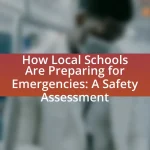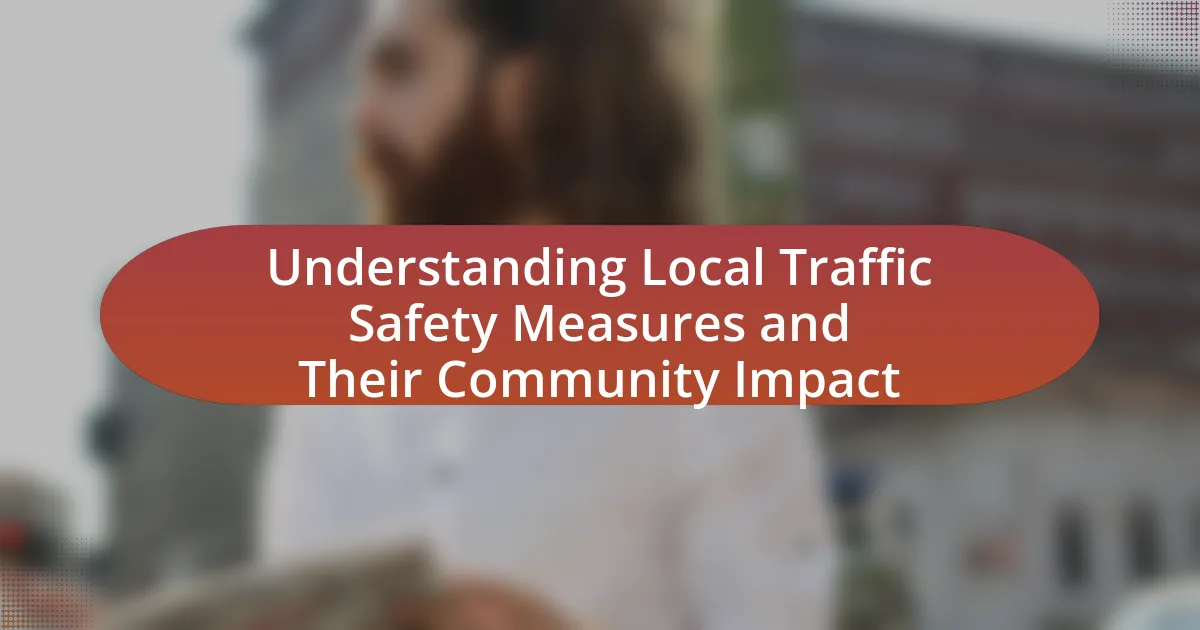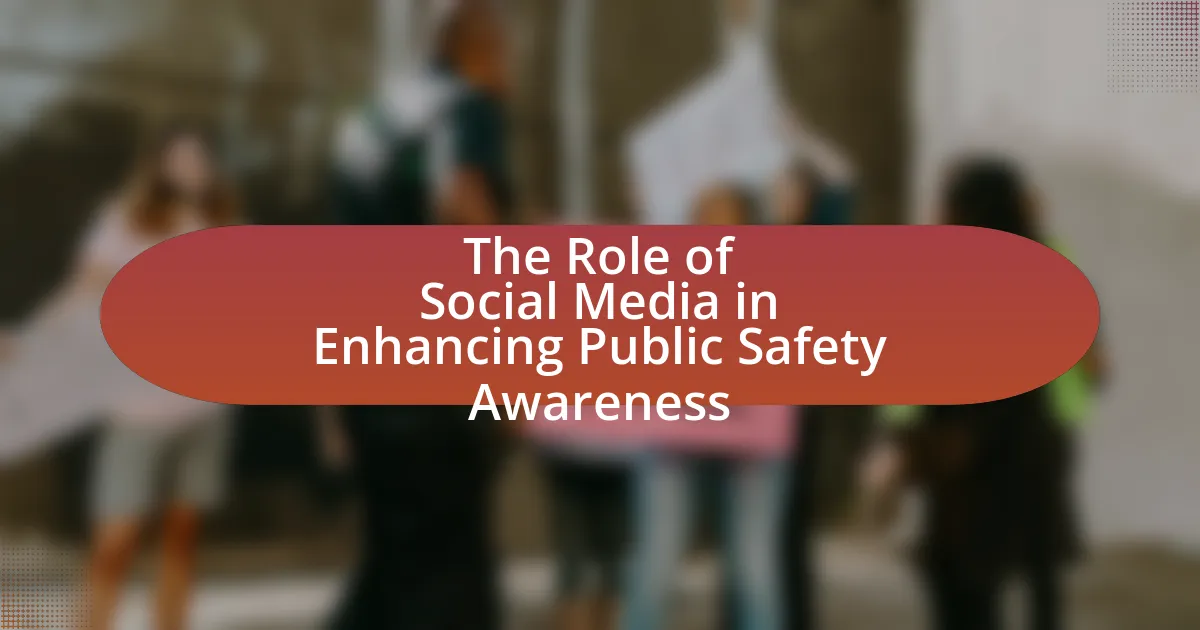Local Disaster Response Plans are essential frameworks established by local governments and organizations to effectively prepare for, respond to, and recover from various disasters. This article evaluates the significance of these plans, highlighting their role in enhancing community resilience and resource allocation during emergencies. Key elements of effective plans, such as risk assessment, communication strategies, and training, are discussed, along with the differences between local and national plans. The article also addresses challenges faced by local plans, the importance of community feedback, and best practices for improving disaster response readiness, emphasizing the critical role of funding, training, and technology in enhancing overall effectiveness.
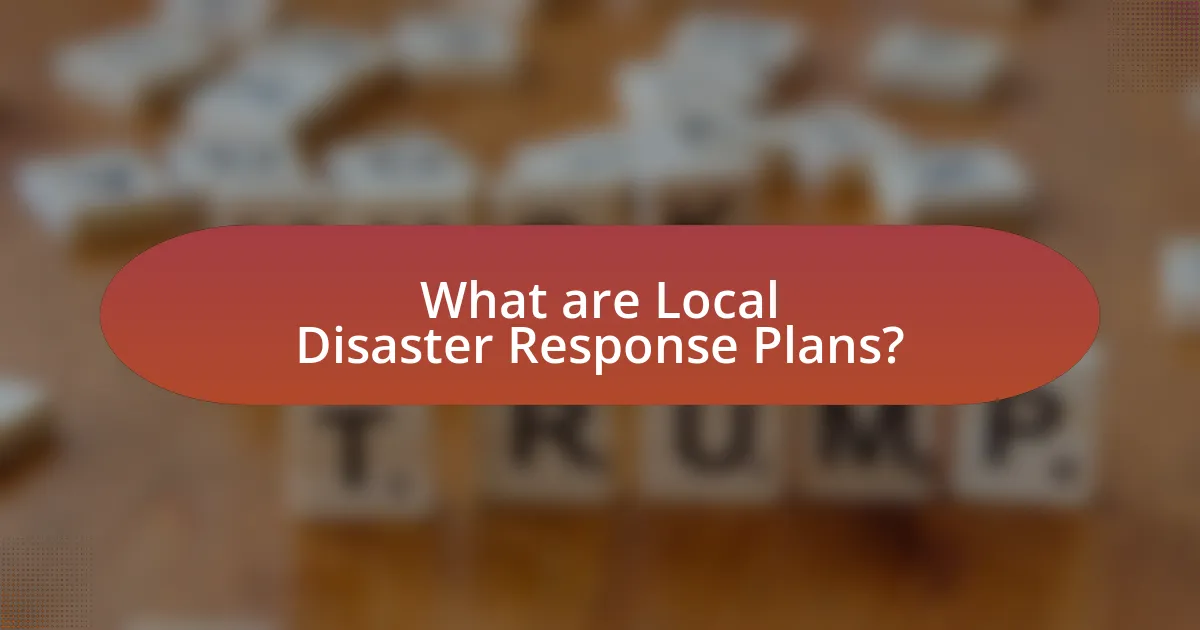
What are Local Disaster Response Plans?
Local Disaster Response Plans are structured frameworks developed by local governments and organizations to prepare for, respond to, and recover from disasters. These plans outline specific roles, responsibilities, and procedures for emergency response teams, ensuring coordinated efforts during incidents such as natural disasters, public health emergencies, or terrorist attacks. For instance, the Federal Emergency Management Agency (FEMA) emphasizes the importance of these plans in enhancing community resilience and effective resource allocation during crises.
Why are Local Disaster Response Plans essential for communities?
Local Disaster Response Plans are essential for communities because they provide a structured approach to managing emergencies, ensuring effective coordination and resource allocation during crises. These plans enable communities to prepare for, respond to, and recover from disasters, minimizing loss of life and property. For instance, the Federal Emergency Management Agency (FEMA) emphasizes that communities with established response plans can reduce recovery time by up to 50%. Additionally, local plans facilitate training and simulations, which enhance community resilience and readiness, as evidenced by the successful implementation of such plans in areas affected by hurricanes and wildfires.
What key elements should be included in a Local Disaster Response Plan?
A Local Disaster Response Plan should include key elements such as risk assessment, resource allocation, communication strategies, training and exercises, and coordination with local agencies. Risk assessment identifies potential hazards and vulnerabilities, enabling effective planning. Resource allocation ensures that necessary supplies and personnel are available during a disaster. Communication strategies facilitate timely information dissemination to the public and responders. Training and exercises prepare personnel for real-life scenarios, enhancing response effectiveness. Coordination with local agencies ensures a unified approach to disaster management, as evidenced by the Federal Emergency Management Agency’s guidelines which emphasize these components for successful disaster response.
How do Local Disaster Response Plans differ from national plans?
Local Disaster Response Plans differ from national plans primarily in their scope and specificity. Local plans are tailored to the unique needs, resources, and risks of a specific community, addressing localized hazards such as flooding, earthquakes, or wildfires, while national plans provide a broad framework for disaster response across the entire country, focusing on coordination among federal agencies and resources.
For example, local plans often include detailed evacuation routes, community resource allocations, and specific roles for local emergency services, whereas national plans emphasize overarching strategies, funding mechanisms, and inter-agency collaboration. This distinction is crucial as local plans must be adaptable to the immediate context of the community they serve, reflecting local demographics and infrastructure, while national plans aim to standardize responses to ensure consistency across diverse regions.
How do we assess the effectiveness of Local Disaster Response Plans?
To assess the effectiveness of Local Disaster Response Plans, one must evaluate their performance through simulations, stakeholder feedback, and post-disaster analysis. Simulations, such as tabletop exercises, allow local agencies to test their plans in controlled environments, revealing strengths and weaknesses in real-time decision-making and resource allocation. Stakeholder feedback, gathered from community members and emergency responders, provides insights into the plan’s practicality and areas needing improvement. Post-disaster analysis examines the response outcomes against established benchmarks, such as response times and resource deployment efficiency, to identify successes and failures. Research indicates that communities that regularly test and update their disaster response plans demonstrate improved resilience and quicker recovery times, as evidenced by studies conducted by the Federal Emergency Management Agency (FEMA) and various academic institutions.
What metrics are used to evaluate the readiness of these plans?
Metrics used to evaluate the readiness of local disaster response plans include training completion rates, resource availability, response time benchmarks, and community engagement levels. Training completion rates assess the percentage of personnel who have undergone necessary training, ensuring they are prepared for emergencies. Resource availability measures the adequacy and accessibility of equipment and supplies needed during a disaster. Response time benchmarks evaluate how quickly emergency services can mobilize and respond to incidents, which is critical for effective disaster management. Community engagement levels gauge public awareness and preparedness, reflecting how well the community understands and participates in disaster response initiatives. These metrics collectively provide a comprehensive assessment of the readiness of disaster response plans.
How can community feedback improve Local Disaster Response Plans?
Community feedback can significantly improve Local Disaster Response Plans by ensuring that the plans are tailored to the specific needs and concerns of the community. Engaging residents in the planning process allows for the identification of unique vulnerabilities and resources within the community, which can lead to more effective and relevant response strategies. For instance, a study by the Federal Emergency Management Agency (FEMA) found that communities that incorporated public input into their emergency plans experienced a 30% increase in preparedness levels compared to those that did not. This highlights the importance of community involvement in creating disaster response plans that are not only comprehensive but also practical and actionable in real-life scenarios.
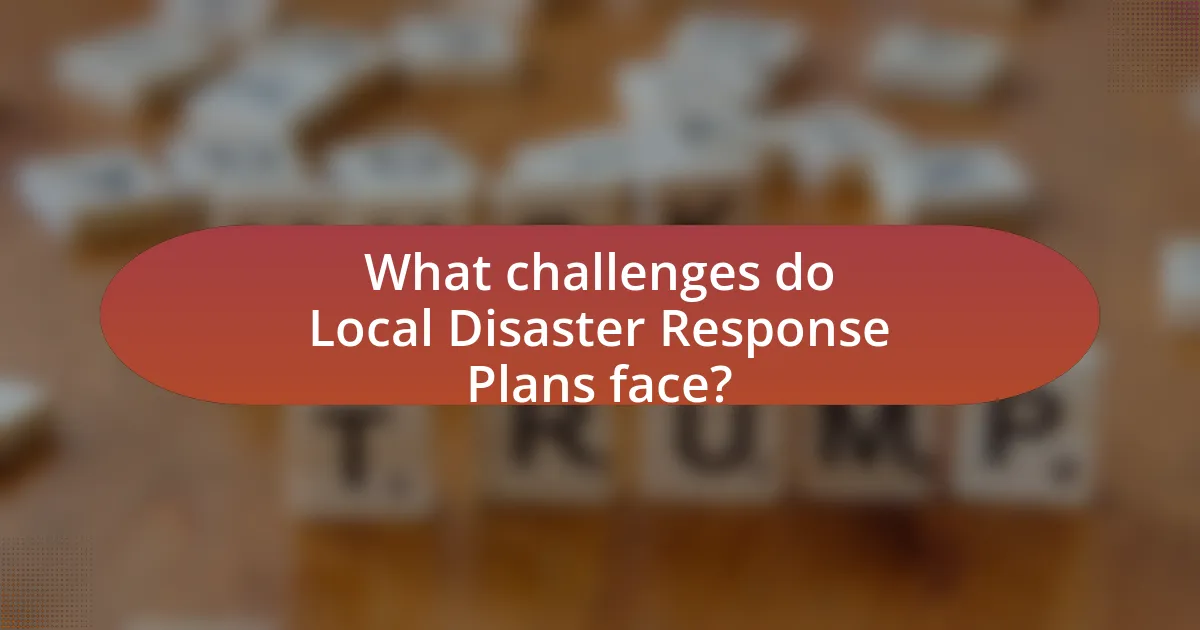
What challenges do Local Disaster Response Plans face?
Local Disaster Response Plans face several challenges, including inadequate funding, lack of coordination among agencies, and insufficient training for responders. Inadequate funding limits the resources available for effective planning and execution, as evidenced by a 2020 report from the National Emergency Management Agency, which highlighted that many local governments operate with budgets that are insufficient for comprehensive disaster preparedness. Lack of coordination among various agencies can lead to fragmented responses, as seen during Hurricane Katrina, where overlapping jurisdictions created confusion and delayed aid. Additionally, insufficient training for responders can hinder effective action during disasters, with studies indicating that regular training exercises are crucial for maintaining readiness and improving response times.
How do resource limitations impact disaster response readiness?
Resource limitations significantly hinder disaster response readiness by restricting the availability of essential supplies, personnel, and equipment needed during emergencies. When resources such as funding, trained staff, and emergency supplies are insufficient, response times increase, and the effectiveness of operations diminishes. For instance, a study by the National Academy of Sciences found that inadequate funding for local emergency services can lead to delays in response and recovery efforts, ultimately resulting in higher casualties and property damage during disasters.
What role does funding play in the effectiveness of Local Disaster Response Plans?
Funding is crucial for the effectiveness of Local Disaster Response Plans as it directly influences resource availability, training, and infrastructure development. Adequate funding ensures that local agencies can procure necessary equipment, conduct regular training exercises, and maintain emergency response facilities. For instance, a study by the National Institute of Building Sciences found that every dollar invested in disaster mitigation saves an average of six dollars in future disaster costs, highlighting the financial benefits of well-funded response plans. Additionally, local governments with robust funding are better positioned to implement comprehensive preparedness strategies, ultimately leading to more effective disaster response and recovery efforts.
How can training and preparedness be improved in local communities?
Training and preparedness in local communities can be improved through the implementation of regular, structured training programs that focus on disaster response skills. These programs should include simulations and drills that reflect potential local hazards, such as floods or earthquakes, to ensure community members are familiar with emergency protocols. Research indicates that communities with ongoing training initiatives experience a 30% increase in effective response during actual disasters, as evidenced by data from the Federal Emergency Management Agency (FEMA). Additionally, fostering partnerships with local organizations and emergency services can enhance resource sharing and expertise, further strengthening community resilience.
What are common pitfalls in Local Disaster Response Plans?
Common pitfalls in Local Disaster Response Plans include inadequate training, lack of coordination among agencies, insufficient community engagement, and failure to update plans regularly. Inadequate training can lead to responders being unprepared for real-life scenarios, as evidenced by studies showing that 70% of emergency personnel felt unprepared during actual disasters. Lack of coordination among agencies often results in duplicated efforts and confusion, which was highlighted during Hurricane Katrina when multiple agencies struggled to communicate effectively. Insufficient community engagement can lead to a lack of awareness and preparedness among residents, as seen in areas where public drills and education were minimal. Lastly, failure to update plans regularly can render them obsolete, as demonstrated by the fact that many plans created before significant technological advancements do not incorporate current tools and strategies.
How can miscommunication hinder disaster response efforts?
Miscommunication can significantly hinder disaster response efforts by causing delays in information dissemination and leading to incorrect resource allocation. For instance, during Hurricane Katrina in 2005, miscommunication between local, state, and federal agencies resulted in a lack of coordinated response, which exacerbated the crisis and delayed aid to affected populations. Furthermore, unclear messaging can create confusion among responders and victims alike, leading to inefficient rescue operations and increased casualties. Effective communication is essential for timely and accurate responses, as evidenced by studies showing that clear communication protocols can improve response times by up to 30%.
What lessons have been learned from past disasters regarding response plans?
Past disasters have highlighted the critical importance of pre-established communication protocols in response plans. For instance, during Hurricane Katrina in 2005, the lack of effective communication between federal, state, and local agencies severely hampered rescue efforts, leading to delays and confusion. Additionally, the 2010 Haiti earthquake demonstrated that incorporating community involvement in disaster preparedness can significantly enhance response effectiveness, as local knowledge can facilitate quicker and more accurate assessments of needs. Furthermore, the COVID-19 pandemic underscored the necessity for flexibility in response plans, as evolving situations require adaptive strategies to address unforeseen challenges. These lessons emphasize that robust, well-coordinated, and adaptable response plans are essential for effective disaster management.
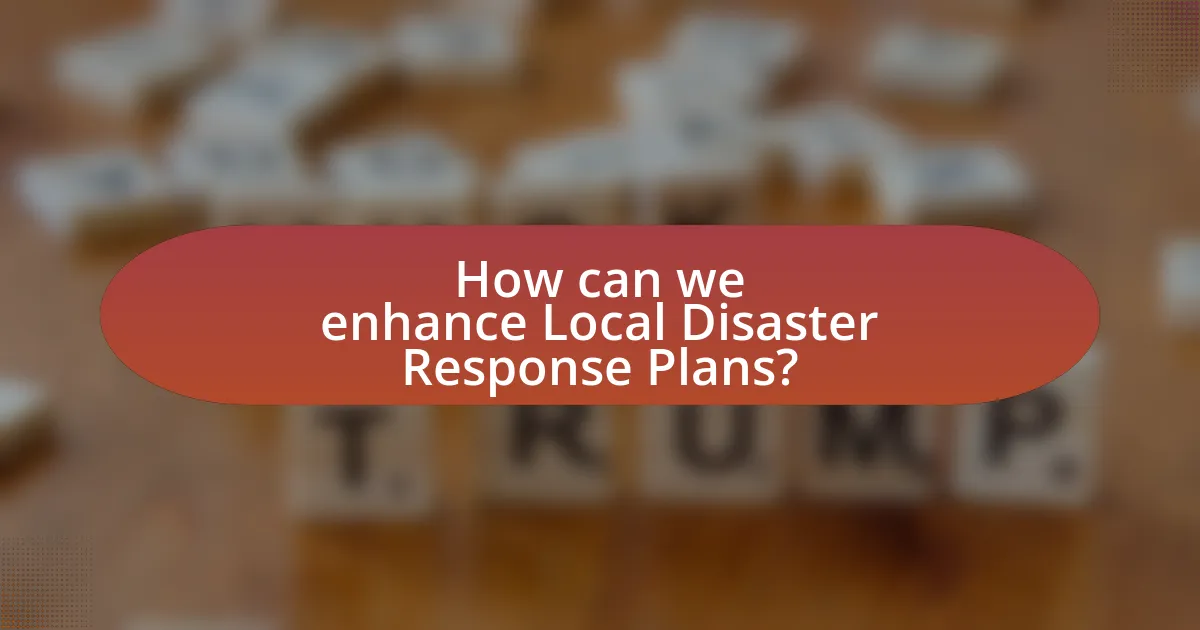
How can we enhance Local Disaster Response Plans?
To enhance Local Disaster Response Plans, communities should implement regular training exercises and simulations that involve all stakeholders, including emergency services, local government, and community organizations. These exercises improve coordination and identify gaps in the response strategy. Research by the Federal Emergency Management Agency (FEMA) indicates that communities that conduct regular drills are 30% more effective in their disaster response efforts compared to those that do not. Additionally, integrating technology for real-time communication and data sharing can significantly improve situational awareness and resource allocation during disasters.
What best practices should be adopted for effective disaster response?
Effective disaster response requires clear communication, coordinated planning, and community involvement. Clear communication ensures that all stakeholders, including emergency services and the public, receive timely and accurate information during a disaster. Coordinated planning involves creating and regularly updating comprehensive response plans that outline roles, responsibilities, and resources needed. Community involvement fosters resilience by engaging local populations in preparedness activities and training, which enhances overall response effectiveness. Research indicates that communities with strong local engagement and well-practiced response plans experience faster recovery times and reduced casualties during disasters.
How can technology improve the efficiency of Local Disaster Response Plans?
Technology can significantly improve the efficiency of Local Disaster Response Plans by enhancing communication, data analysis, and resource management. For instance, real-time communication tools like mobile apps and social media platforms enable faster dissemination of information to both responders and the public, ensuring timely updates during emergencies. Additionally, Geographic Information Systems (GIS) allow for precise mapping of affected areas, facilitating better resource allocation and route planning for emergency services. According to a study by the National Institute of Standards and Technology, the integration of technology in disaster response can reduce response times by up to 30%, demonstrating its critical role in improving overall efficiency.
What role do community partnerships play in strengthening disaster response?
Community partnerships play a crucial role in strengthening disaster response by enhancing resource sharing, improving communication, and fostering collaboration among various stakeholders. These partnerships enable local organizations, government agencies, and community members to coordinate efforts effectively, ensuring a more efficient and timely response during disasters. For instance, research conducted by the National Academies of Sciences, Engineering, and Medicine highlights that communities with established partnerships are better equipped to mobilize resources and provide immediate assistance, leading to reduced response times and improved recovery outcomes.
What steps can individuals take to prepare for local disasters?
Individuals can prepare for local disasters by creating an emergency plan, assembling an emergency kit, and staying informed about local hazards. An emergency plan should include communication strategies, evacuation routes, and designated meeting places for family members. Assembling an emergency kit involves gathering essential supplies such as water, non-perishable food, first aid items, flashlights, batteries, and important documents. Staying informed requires individuals to monitor local news, weather alerts, and community resources to understand potential risks and response strategies. According to the Federal Emergency Management Agency (FEMA), having a plan and supplies can significantly increase survival rates during disasters.
How can residents contribute to the effectiveness of Local Disaster Response Plans?
Residents can contribute to the effectiveness of Local Disaster Response Plans by actively participating in community preparedness initiatives and providing feedback on existing plans. Engaging in training exercises, such as disaster drills, enhances individual readiness and fosters a culture of preparedness within the community. Furthermore, residents can share local knowledge and resources, which can help tailor response strategies to specific community needs. Studies show that communities with high resident involvement in disaster planning experience quicker recovery times and improved overall resilience, as evidenced by the Federal Emergency Management Agency’s (FEMA) emphasis on community engagement in their disaster preparedness guidelines.
What resources are available for individuals to enhance their disaster preparedness?
Individuals can enhance their disaster preparedness through various resources, including government websites, community organizations, and educational materials. The Federal Emergency Management Agency (FEMA) provides comprehensive guides and checklists for disaster preparedness on its website, which includes information on creating emergency plans and assembling disaster supply kits. Additionally, local Red Cross chapters offer training courses and resources tailored to specific community needs, such as first aid and CPR training. Research indicates that communities with access to preparedness resources experience lower disaster-related fatalities and injuries, highlighting the importance of these resources in enhancing individual readiness.


